Abstract
Carcinogenic activation of polycyclic aromatic hydrocarbons (PAH) involves two main pathways: one-electron oxidation and monooxygenation. One-electron oxidation produces PAH radical cations, which can react with cellular nucleophiles. Results from biochemical and biological experiments indicate that only PAH with ionization potentials below ca. 7.35 eV can be metabolically activated by one-electron oxidation. In addition, the radical cations of carcinogenic PAH must have relatively high charge localization to react effectively with macromolecules in target cells. Metabolic formation of PAH quinones proceeds through radical cation intermediates. Binding of benzo[a]pyrene (BP) to mouse skin DNA occurs predominantly at C-6, the position of highest charge localization in the BP radical cation, and binding of 6-methyl BP to DNA in mouse skin yields a major adduct with the 6-methyl group bound to the 2-amino group of deoxyguanosine. Studies of carcinogenicity by direct application of PAH to rat mammary gland indicate that only PAH with ionization potentials low enough for activation by one-electron oxidation produce tumors in this target tissue. These constitute some of the results which provide evidence for the involvement of one-electron oxidation in PAH carcinogenesis.
Full text
PDF

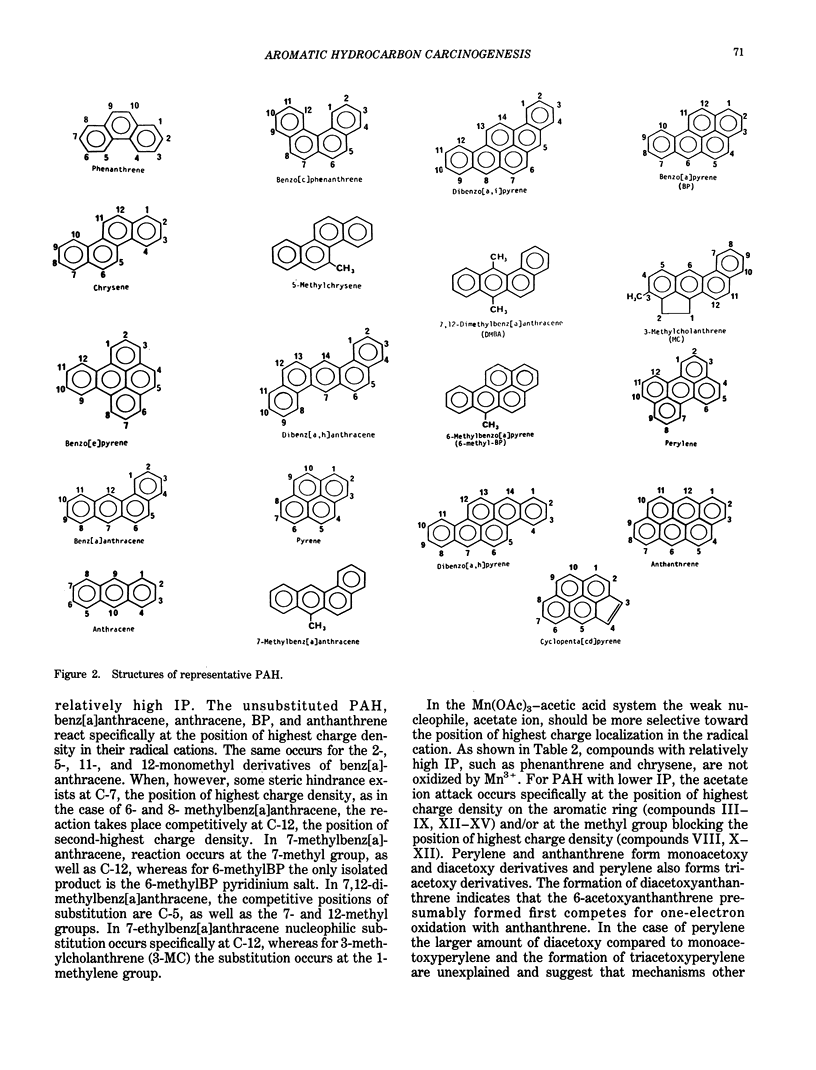
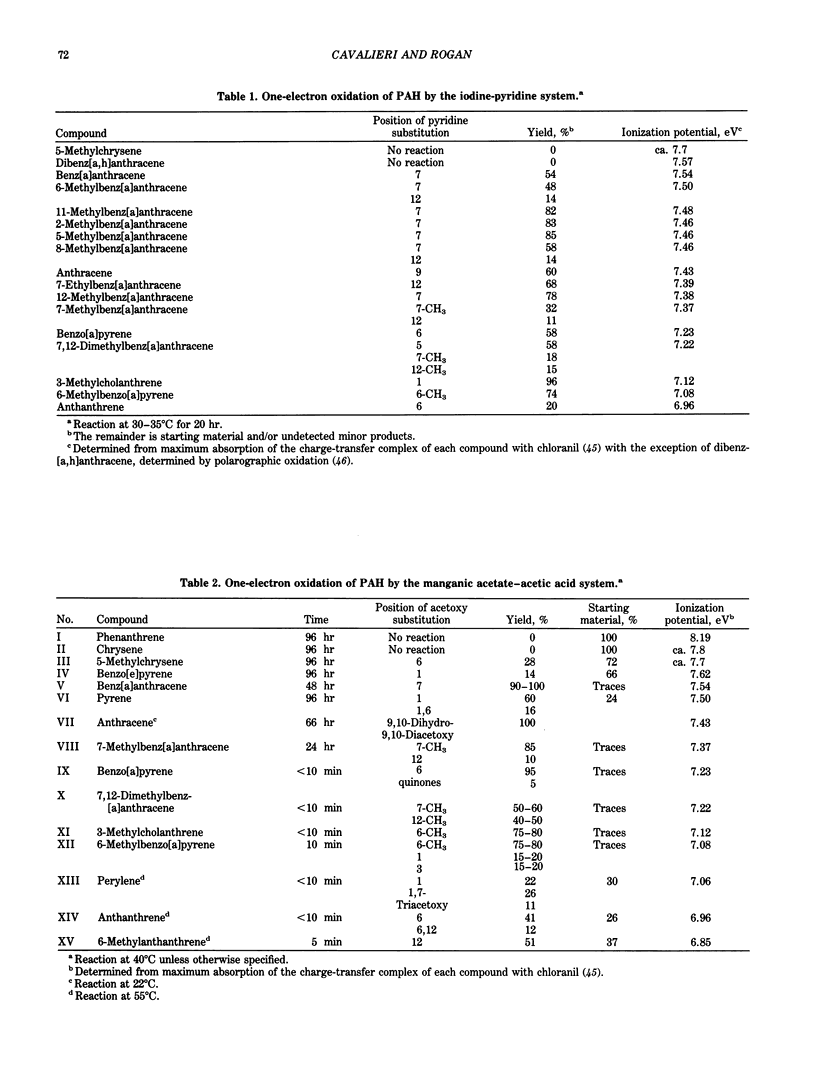
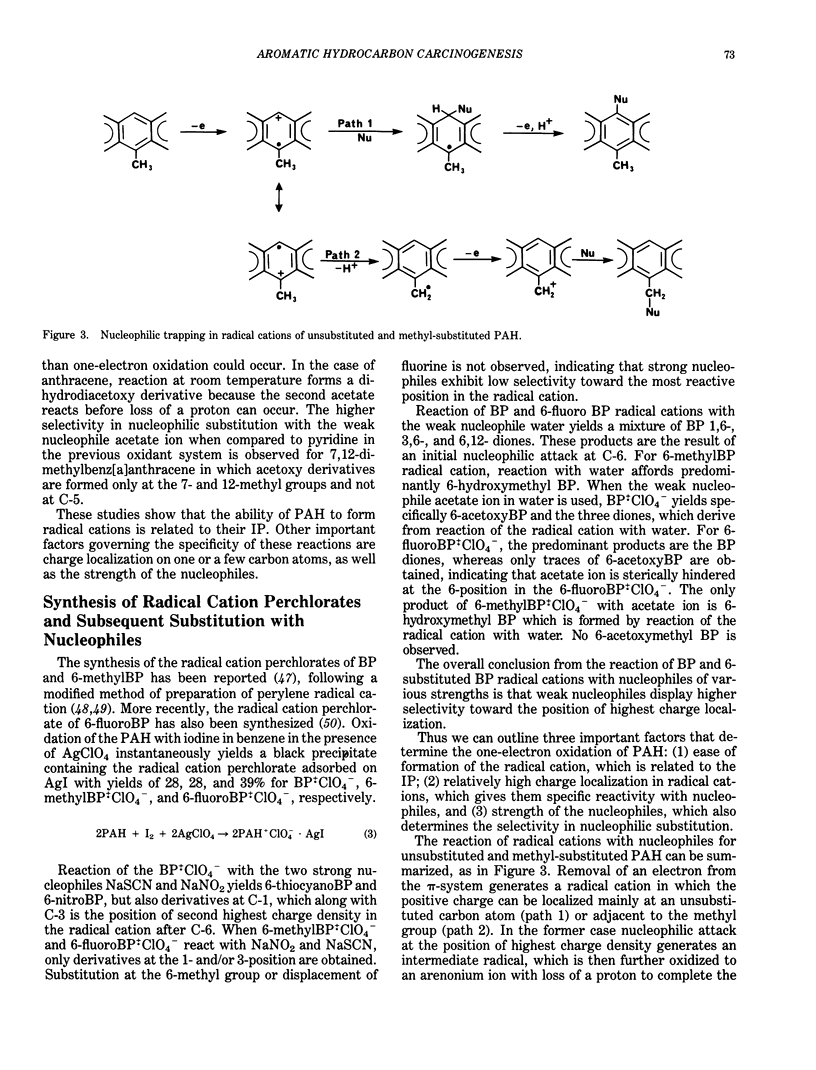
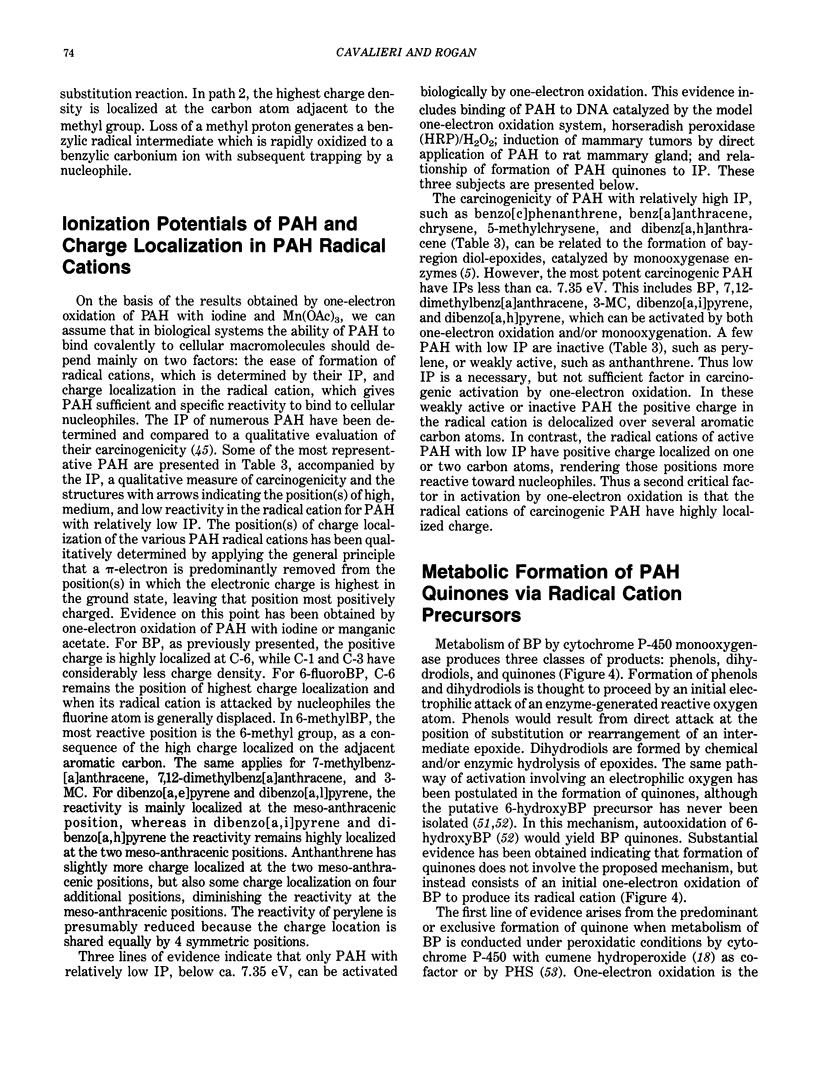
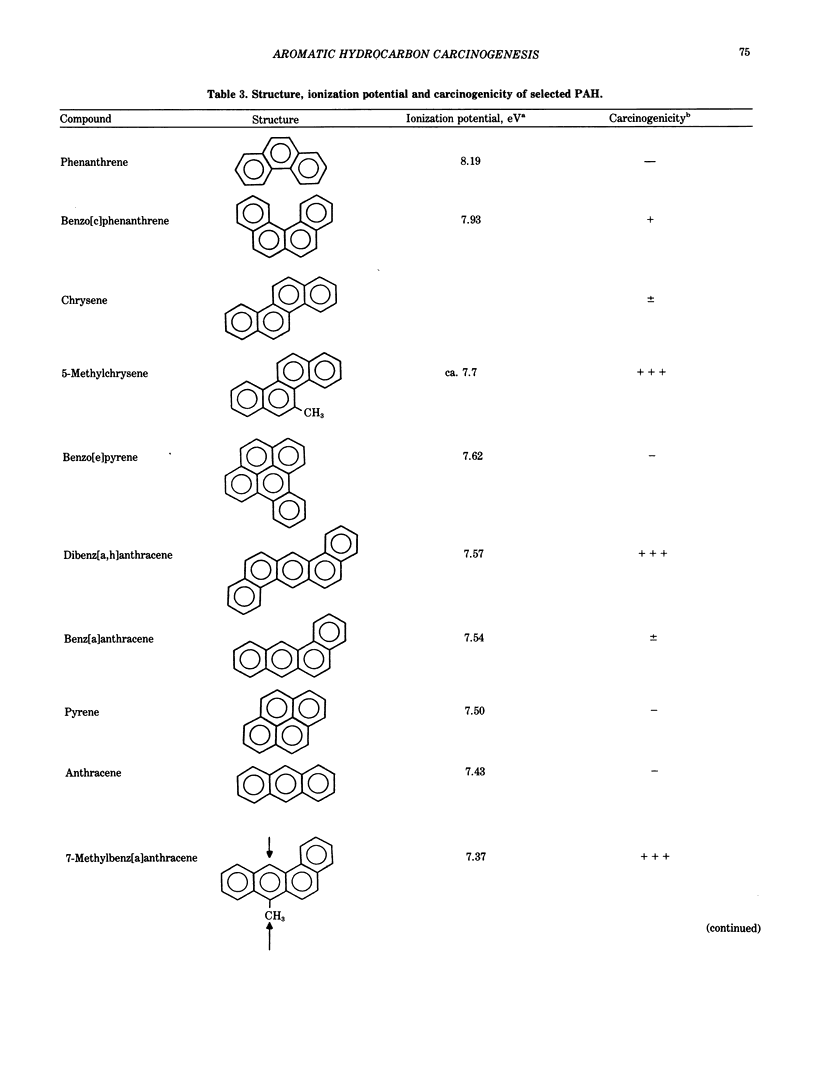
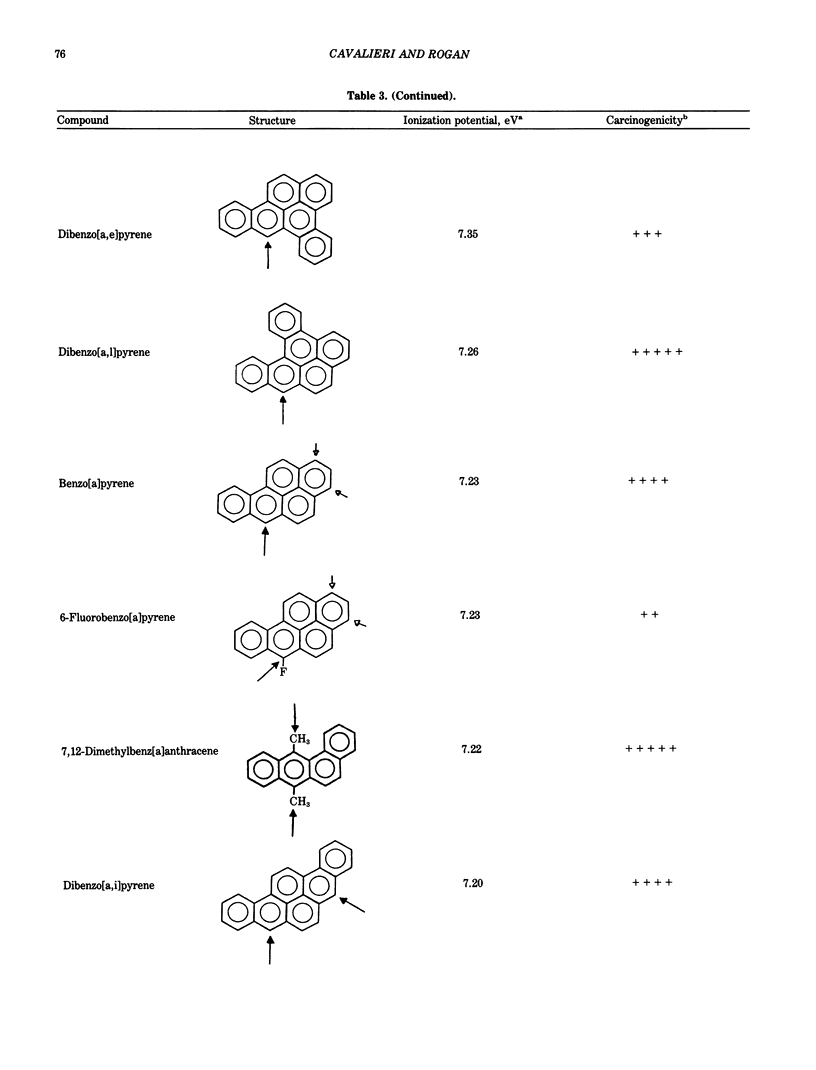
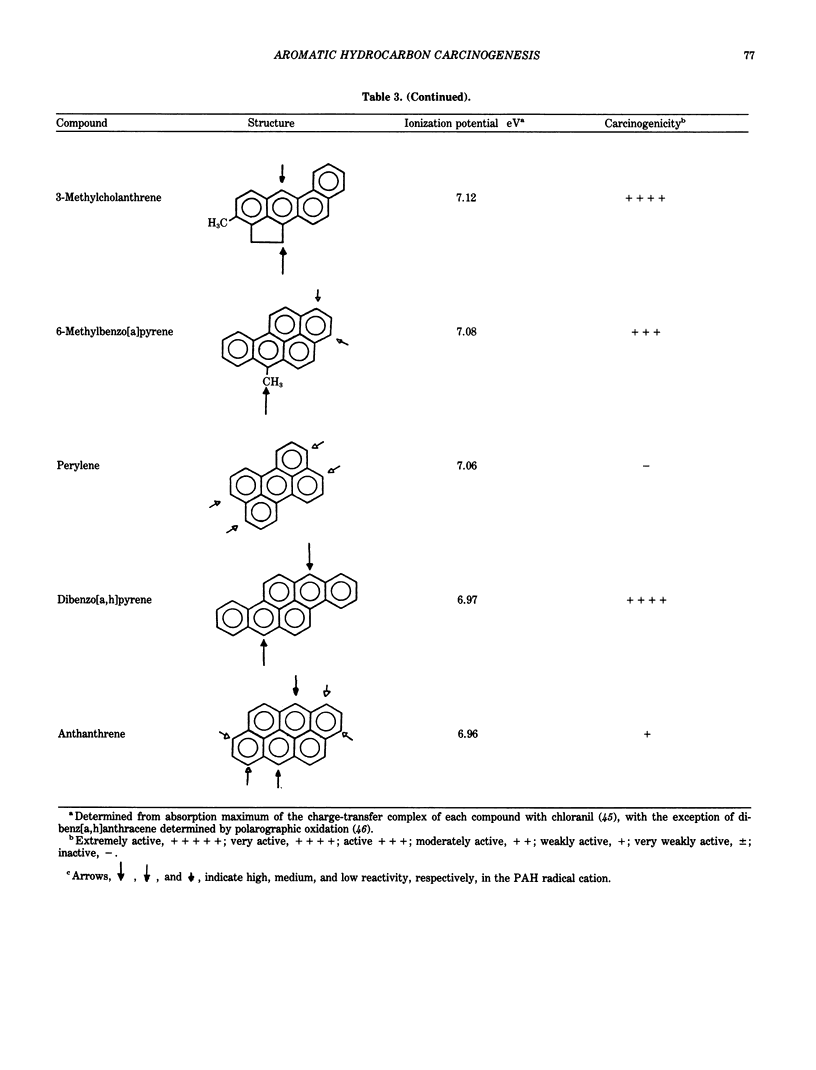
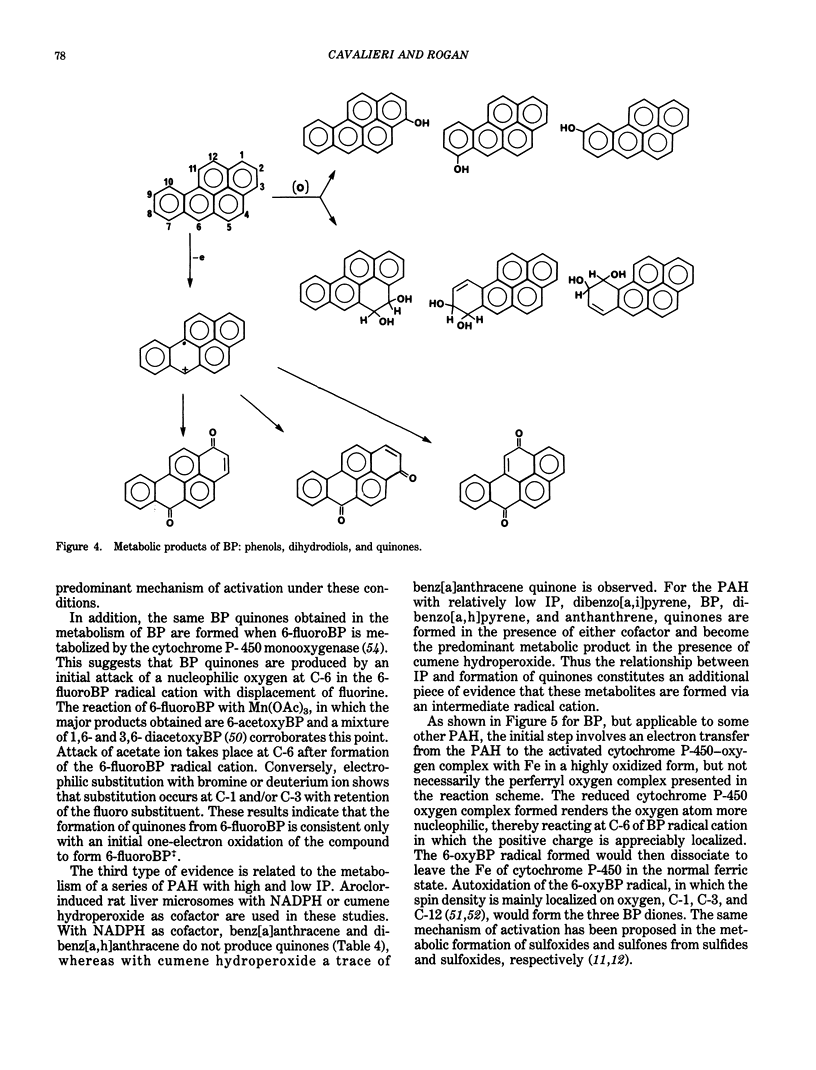
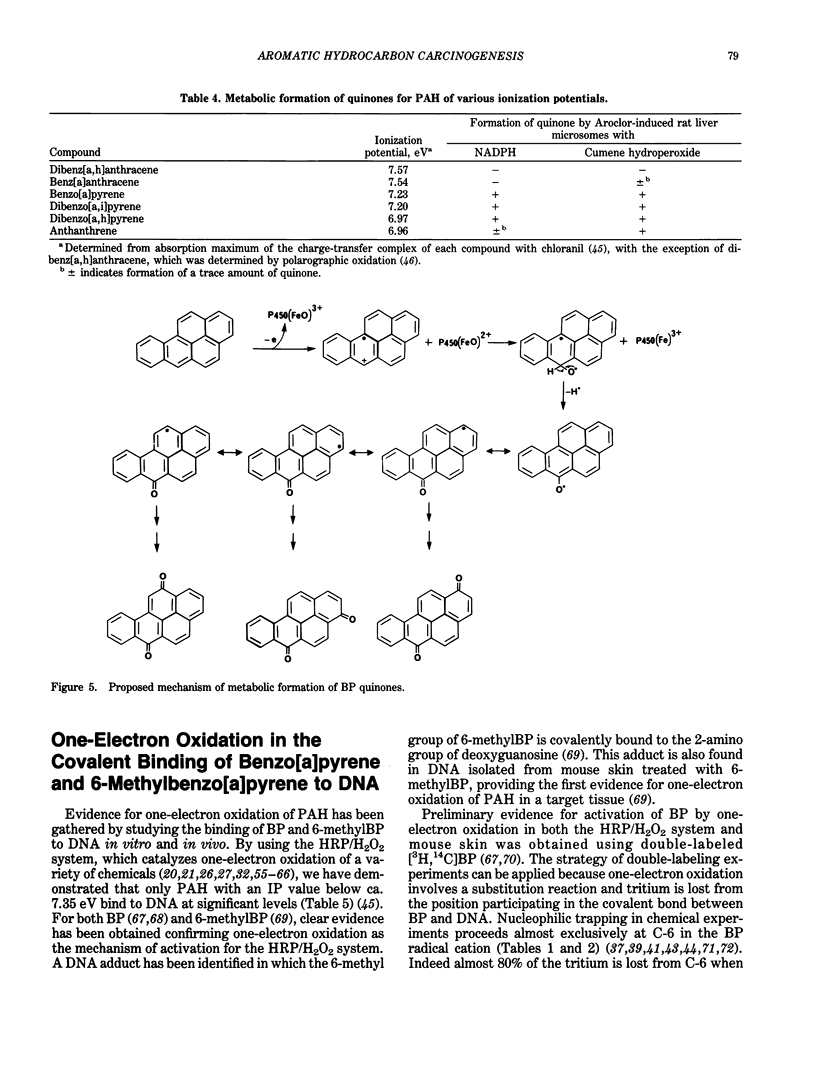

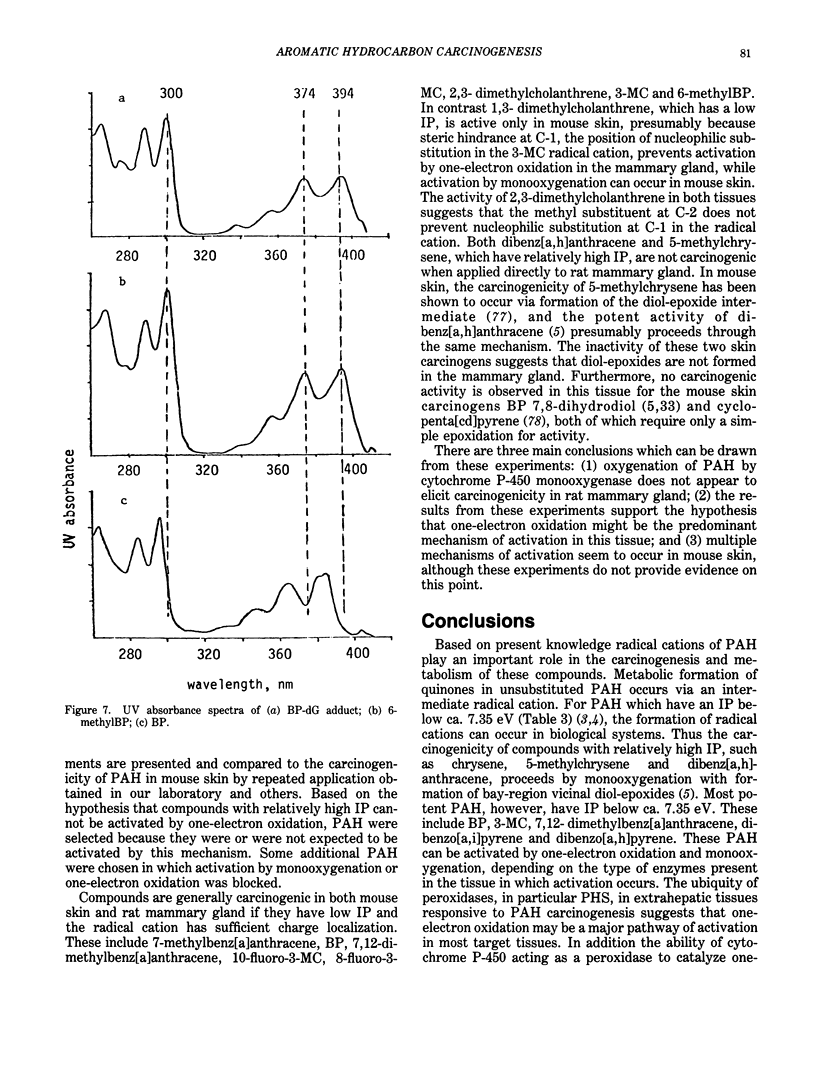
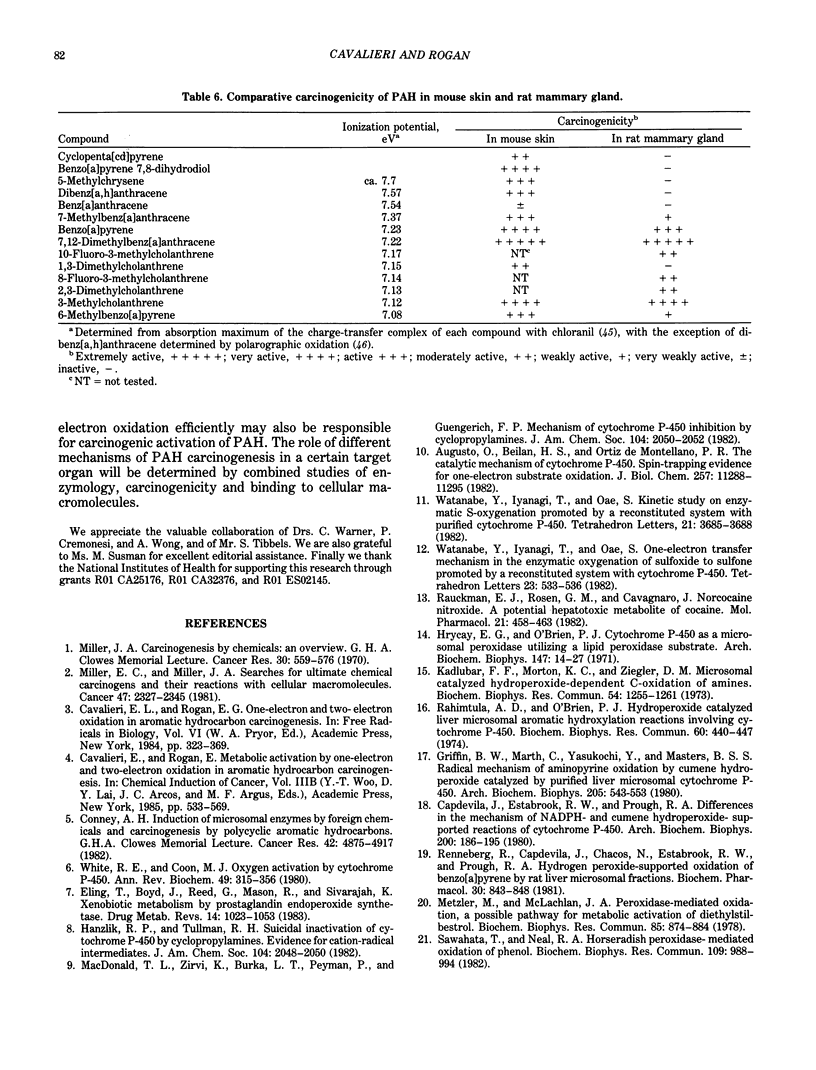
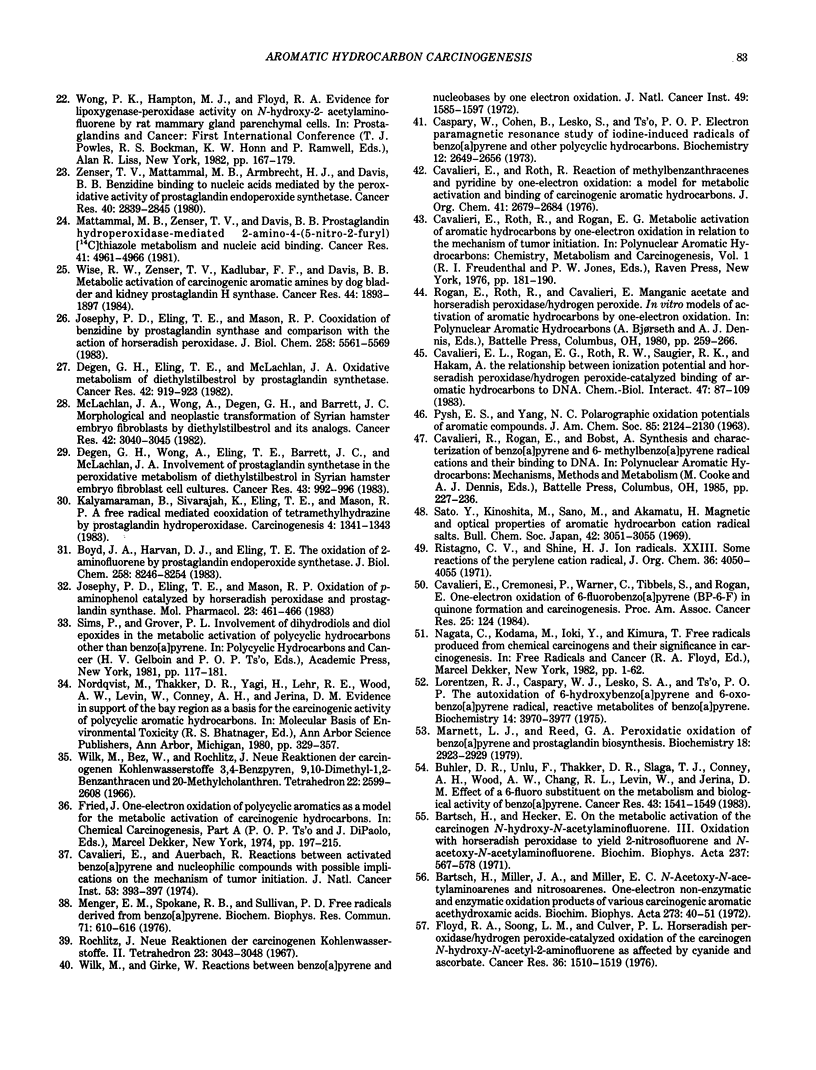
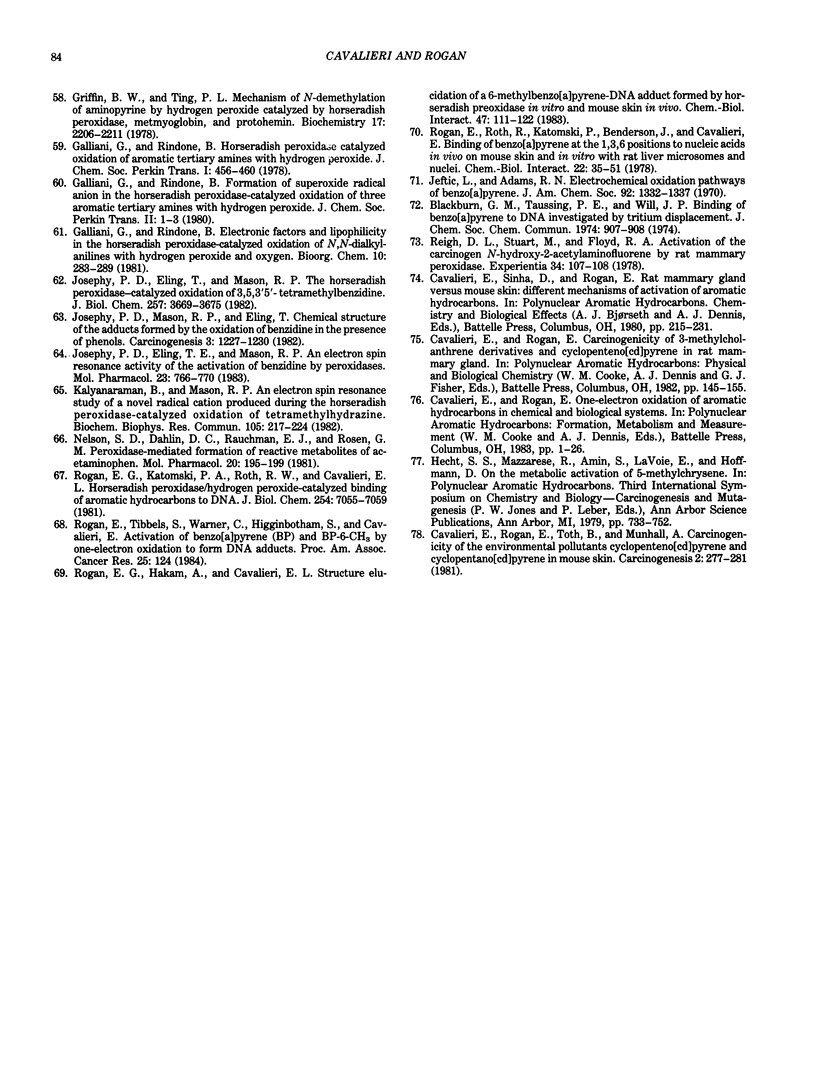
Selected References
These references are in PubMed. This may not be the complete list of references from this article.
- Augusto O., Beilan H. S., Ortiz de Montellano P. R. The catalytic mechanism of cytochrome P-450. Spin-trapping evidence for one-electron substrate oxidation. J Biol Chem. 1982 Oct 10;257(19):11288–11295. [PubMed] [Google Scholar]
- Bartsch H., Hecker E. On the metabolic activation of the carcinogen N-hydroxy-N-2-acetylaminofluorene. 3. Oxidation with horseradish peroxidase to yield 2-nitrosofluorene and N-acetoxy-N-2-acetylaminofluorene. Biochim Biophys Acta. 1971 Jun 22;237(3):567–578. doi: 10.1016/0304-4165(71)90277-7. [DOI] [PubMed] [Google Scholar]
- Bartsch H., Miller J. A., Miller E. C. N-acetoxy-N-acetylaminoarenes and nitrosoarenes. One-electron non-enzymatic and enzymatic oxidation products of various carcinogenic aromatic acethydroxamic acids. Biochim Biophys Acta. 1972 Jun 26;273(1):40–51. doi: 10.1016/0304-4165(72)90189-4. [DOI] [PubMed] [Google Scholar]
- Boyd J. A., Harvan D. J., Eling T. E. The oxidation of 2-aminofluorene by prostaglandin endoperoxide synthetase. Comparison with other peroxidases. J Biol Chem. 1983 Jul 10;258(13):8246–8254. [PubMed] [Google Scholar]
- Buhler D. R., Unlü F., Thakker D. R., Slaga T. J., Conney A. H., Wood A. W., Chang R. L., Levin W., Jerina D. M. Effect of a 6-fluoro substituent on the metabolism and biological activity of benzo(a)pyrene. Cancer Res. 1983 Apr;43(4):1541–1549. [PubMed] [Google Scholar]
- Capdevila J., Estabrook R. W., Prough R. A. Differences in the mechanism of NADPH- and cumene hydroperoxide-supported reactions of cytochrome P-450. Arch Biochem Biophys. 1980 Mar;200(1):186–195. doi: 10.1016/0003-9861(80)90345-8. [DOI] [PubMed] [Google Scholar]
- Caspary W., Cohen B., Lesko S., Ts'o P. O. Electron paramagnetic resonance study of iodine-induced radicals of benzo( ) pyrene and other polycyclic hydrocarbons. Biochemistry. 1973 Jul 3;12(14):2649–2656. doi: 10.1021/bi00738a016. [DOI] [PubMed] [Google Scholar]
- Cavalieri E. L., Rogan E. G., Roth R. W., Saugier R. K., Hakam A. The relationship between ionization potential and horseradish peroxidase/hydrogen peroxide-catalyzed binding of aromatic hydrocarbons to DNA. Chem Biol Interact. 1983 Oct 15;47(1):87–109. doi: 10.1016/0009-2797(83)90150-3. [DOI] [PubMed] [Google Scholar]
- Cavalieri E., Auerbach R. Reactions between activated benzo(a)pyrene and nucleophilic compounds, with possible implications on the mechanism of tumor initiation. J Natl Cancer Inst. 1974 Aug;53(2):393–397. doi: 10.1093/jnci/53.2.393. [DOI] [PubMed] [Google Scholar]
- Cavalieri E., Rogan E., Toth B., Munhall A. Carcinogenicity of the environmental pollutants cyclopenteno-[cd]pyrene and cyclopentano[cd]pyrene in mouse skin. Carcinogenesis. 1981;2(4):277–281. doi: 10.1093/carcin/2.4.277. [DOI] [PubMed] [Google Scholar]
- Cavalieri E., Roth R. Reaction of methylbenzanthracenes and pyridine by one-electron oxidation. A model for metabolic activation and binding of carcinogenic aromatic hydrocarbons. J Org Chem. 1976 Aug 6;41(16):2679–2684. doi: 10.1021/jo00878a004. [DOI] [PubMed] [Google Scholar]
- Conney A. H. Induction of microsomal enzymes by foreign chemicals and carcinogenesis by polycyclic aromatic hydrocarbons: G. H. A. Clowes Memorial Lecture. Cancer Res. 1982 Dec;42(12):4875–4917. [PubMed] [Google Scholar]
- Degen G. H., Eling T. E., McLachlan J. A. Oxidative metabolism of diethylstilbestrol by prostaglandin synthetase. Cancer Res. 1982 Mar;42(3):919–923. [PubMed] [Google Scholar]
- Degen G. H., Wong A., Eling T. E., Barrett J. C., McLachlan J. A. Involvement of prostaglandin synthetase in the peroxidative metabolism of diethylstilbestrol in Syrian hamster embryo fibroblast cell cultures. Cancer Res. 1983 Mar;43(3):992–996. [PubMed] [Google Scholar]
- Eling T., Boyd J., Reed G., Mason R., Sivarajah K. Xenobiotic metabolism by prostaglandin endoperoxide synthetase. Drug Metab Rev. 1983;14(5):1023–1053. doi: 10.3109/03602538308991420. [DOI] [PubMed] [Google Scholar]
- Floyd R. A., Soong L. M., Culver P. L. Horseradish peroxidase/hydrogen peroxide-catalyzed oxidation of the carcinogen N-hydroxy-N-acetyl-2-aminofluorene as effected by cyanide and ascorbate. Cancer Res. 1976 Apr;36(4):1510–1519. [PubMed] [Google Scholar]
- Griffin B. W., Marth C., Yasukochi Y., Masters B. S. Radical mechanism of aminopyrine oxidation by cumene hydroperoxide catalyzed by purified liver microsomal cytochrome P-450. Arch Biochem Biophys. 1980 Dec;205(2):543–553. doi: 10.1016/0003-9861(80)90137-x. [DOI] [PubMed] [Google Scholar]
- Griffin B. W., Ting P. L. Mechanism of N-demethylation of aminopyrine by hydrogen peroxide catalyzed by horseradish peroxidase, metmyoglobin, and protohemin. Biochemistry. 1978 May 30;17(11):2206–2211. doi: 10.1021/bi00604a029. [DOI] [PubMed] [Google Scholar]
- Hrycay E. G., O'Brien P. J. Cytochrome P-450 as a microsomal peroxidase utilizing a lipid peroxide substrate. Arch Biochem Biophys. 1971 Nov;147(1):14–27. doi: 10.1016/0003-9861(71)90304-3. [DOI] [PubMed] [Google Scholar]
- Jeftić L., Adams R. N. Electrochemical oxidation pathways of benzo [a] pyrene. J Am Chem Soc. 1970 Mar 11;92(5):1332–1337. doi: 10.1021/ja00708a037. [DOI] [PubMed] [Google Scholar]
- Josephy P. D., Eling T. E., Mason R. P. An electron spin resonance study of the activation of benzidine by peroxidases. Mol Pharmacol. 1983 May;23(3):766–770. [PubMed] [Google Scholar]
- Josephy P. D., Eling T. E., Mason R. P. Co-oxidation of benzidine by prostaglandin synthase and comparison with the action of horseradish peroxidase. J Biol Chem. 1983 May 10;258(9):5561–5569. [PubMed] [Google Scholar]
- Josephy P. D., Eling T. E., Mason R. P. Oxidation of p-aminophenol catalyzed by horseradish peroxidase and prostaglandin synthase. Mol Pharmacol. 1983 Mar;23(2):461–466. [PubMed] [Google Scholar]
- Josephy P. D., Eling T., Mason R. P. The horseradish peroxidase-catalyzed oxidation of 3,5,3',5'-tetramethylbenzidine. Free radical and charge-transfer complex intermediates. J Biol Chem. 1982 Apr 10;257(7):3669–3675. [PubMed] [Google Scholar]
- Josephy P. D., Mason R. P., Eling T. Chemical structure of the adducts formed by the oxidation of benzidine in the presence of phenols. Carcinogenesis. 1982;3(10):1227–1230. doi: 10.1093/carcin/3.10.1227. [DOI] [PubMed] [Google Scholar]
- Kadlubar F. F., Morton K. C., Ziegler D. M. Microsomal-catalyzed hydroperoxide-dependent C-oxidation of amines. Biochem Biophys Res Commun. 1973 Oct 15;54(4):1255–1261. doi: 10.1016/0006-291x(73)91122-4. [DOI] [PubMed] [Google Scholar]
- Kalyanaraman B., Mason R. P., Sivarajah K. An electron spin resonance study of the novel radical cation produced during the horseradish peroxidase-catalyzed oxidation of tetramethylhydrazine. Biochem Biophys Res Commun. 1982 Mar 15;105(1):217–224. doi: 10.1016/s0006-291x(82)80033-8. [DOI] [PubMed] [Google Scholar]
- Kalyanaraman B., Sivarajah K., Eling T. E., Mason R. P. A free radical mediated cooxidation of tetramethylhydrazine by prostaglandin hydroperoxidase. Carcinogenesis. 1983 Oct;4(10):1341–1343. doi: 10.1093/carcin/4.10.1341. [DOI] [PubMed] [Google Scholar]
- Marnett L. J., Reed G. A. Peroxidatic oxidation of benzo[a]pyrene and prostaglandin biosynthesis. Biochemistry. 1979 Jul 10;18(14):2923–2929. doi: 10.1021/bi00581a001. [DOI] [PubMed] [Google Scholar]
- Mattammal M. B., Zenser T. V., Davis B. B. Prostaglandin hydroperoxidase-mediated 2-amino-4-(5-nitro-2-furyl) [14C]thiazole metabolism and nucleic acid binding. Cancer Res. 1981 Dec;41(12 Pt 1):4961–4966. [PubMed] [Google Scholar]
- McLachlan J. A., Wong A., Degen G. H., Barrett J. C. Morphologic and neoplastic transformation of Syrian hamster embryo fibroblasts by diethylstilbestrol and its analogs. Cancer Res. 1982 Aug;42(8):3040–3045. [PubMed] [Google Scholar]
- Menger E. M., Spokane R. B., Sullivan P. D. Free radicals derived from benzo[a]pyrene. Biochem Biophys Res Commun. 1976 Jul 26;71(2):610–616. doi: 10.1016/0006-291x(76)90831-7. [DOI] [PubMed] [Google Scholar]
- Metzler M., McLachlan J. A. Peroxidase-mediated oxidation, a possible pathway for metabolic activation of diethylstilbestrol. Biochem Biophys Res Commun. 1978 Dec 14;85(3):874–884. doi: 10.1016/0006-291x(78)90625-3. [DOI] [PubMed] [Google Scholar]
- Miller E. C., Miller J. A. Searches for ultimate chemical carcinogens and their reactions with cellular macromolecules. Cancer. 1981 May 15;47(10):2327–2345. doi: 10.1002/1097-0142(19810515)47:10<2327::aid-cncr2820471003>3.0.co;2-z. [DOI] [PubMed] [Google Scholar]
- Miller J. A. Carcinogenesis by chemicals: an overview--G. H. A. Clowes memorial lecture. Cancer Res. 1970 Mar;30(3):559–576. [PubMed] [Google Scholar]
- Nelson S. D., Dahlin D. C., Rauckman E. J., Rosen G. M. Peroxidase-mediated formation of reactive metabolites of acetaminophen. Mol Pharmacol. 1981 Jul;20(1):195–199. [PubMed] [Google Scholar]
- Rahimtula A. D., O'Brien P. J. Hydroperoxide catalyzed liver microsomal aromatic hydroxylation reactions involving cytochrome P-450. Biochem Biophys Res Commun. 1974 Sep 9;60(1):440–447. doi: 10.1016/0006-291x(74)90223-x. [DOI] [PubMed] [Google Scholar]
- Rauckman E. J., Rosen G. M., Cavagnaro J. Norcocaine nitroxide. A potential hepatotoxic metabolite of cocaine. Mol Pharmacol. 1982 Mar;21(2):458–463. [PubMed] [Google Scholar]
- Reigh D. L., Stuart M., Floyd R. A. Activation of the carcinogen N-hydroxy-2-acetylaminofluorene by rat mammary peroxidase. Experientia. 1978 Jan 15;34(1):107–108. doi: 10.1007/BF01921931. [DOI] [PubMed] [Google Scholar]
- Renneberg R., Capdevila J., Chacos N., Estabrook R. W., Prough R. A. Hydrogen peroxide-supported oxidation of benzo [a]pyrene by rat liver microsomal fractions. Biochem Pharmacol. 1981 Apr 15;30(8):843–848. doi: 10.1016/s0006-2952(81)80005-6. [DOI] [PubMed] [Google Scholar]
- Rochlitz J. Neue Reaktionen der Carcinogenen Kohlenwasserstoffe. II. Tetrahedron. 1967 Jul;23(7):3043–3048. doi: 10.1016/s0040-4020(01)83361-5. [DOI] [PubMed] [Google Scholar]
- Rogan E. G., Hakam A., Cavalieri E. L. Structure elucidation of a 6-methylbenzo[a]pyrene-DNA adduct formed by horseradish peroxidase in vitro and mouse skin in vivo. Chem Biol Interact. 1983 Oct 15;47(1):111–122. doi: 10.1016/0009-2797(83)90151-5. [DOI] [PubMed] [Google Scholar]
- Rogan E. G., Katomski P. A., Roth R. W., Cavalieri E. L. Horseradish peroxidase/hydrogen peroxide-catalyzed binding of aromatic hydrocarbons to DNA. J Biol Chem. 1979 Aug 10;254(15):7055–7059. [PubMed] [Google Scholar]
- Rogan E., Roth R., Katomski P., Benderson J., Cavalieri E. Binding of benzo[a]pyrene at the 1,3,6 positions to nucleic acids in vivo on mouse skin and in vitro with rat liver microsomes and nuclei. Chem Biol Interact. 1978 Jul;22(1):35–51. doi: 10.1016/0009-2797(78)90148-5. [DOI] [PubMed] [Google Scholar]
- Sawahata T., Neal R. A. Horseradish peroxidase-mediated oxidation of phenol. Biochem Biophys Res Commun. 1982 Dec 15;109(3):988–994. doi: 10.1016/0006-291x(82)92037-x. [DOI] [PubMed] [Google Scholar]
- White R. E., Coon M. J. Oxygen activation by cytochrome P-450. Annu Rev Biochem. 1980;49:315–356. doi: 10.1146/annurev.bi.49.070180.001531. [DOI] [PubMed] [Google Scholar]
- Wilk M., Girke W. Reactions between benzo(a)pyrene and nucleobases by one-electron oxidation. J Natl Cancer Inst. 1972 Dec;49(6):1585–1597. doi: 10.1093/jnci/49.6.1585. [DOI] [PubMed] [Google Scholar]
- Wise R. W., Zenser T. V., Kadlubar F. F., Davis B. B. Metabolic activation of carcinogenic aromatic amines by dog bladder and kidney prostaglandin H synthase. Cancer Res. 1984 May;44(5):1893–1897. [PubMed] [Google Scholar]
- Zenser T. V., Mattammal M. B., Armbrecht H. J., Davis B. B. Benzidine binding to nucleic acids mediated by the peroxidative activity of prostaglandin endoperoxide synthetase. Cancer Res. 1980 Aug;40(8 Pt 1):2839–2845. [PubMed] [Google Scholar]


